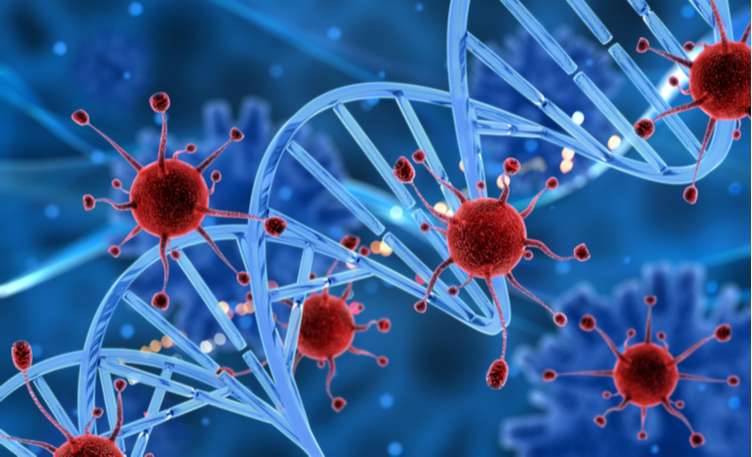How Do Healthy Cells Become Cancerous?

Our body is made up of over 37.2 trillion cells. Cells are the most basic units of life and each cell comprises of its own complex structure that allows it to survive, grow, reproduce and die on its own. Throughout our lives, healthy cells in our body divide and replace themselves in a controlled manner.
When cancer starts to grow within a cell, this cell’s function is altered and it begins to multiply out of control. Simply put, cancer cells are nothing but cells gone wrong - they no longer respond to the signals that control cellular growth and death. Subsequently, they divide more rapidly than their progenitors and become less dependent on signals from other cells.
This happens to the extent that they even evade cell death or apoptosis, despite their multiple abnormalities. As cancer progresses, the cells start to break through normal tissue boundaries and spread to new sites in the body.
How Does Cancer Spread?

Metastasis is the process through which cancer cells spread from the place of origin to the other parts of the body. This occurs via the following steps:
- Cancer cells use the lymphatic system and bloodstream to spread to the other parts of the body.
- Once they reach a small blood vessel at a distant location, they invade into the tissue of the blood vessel and start growing there. This results in the formation of tiny tumours.
- Since the cells are still functioning, the cancer cells cause new blood vessels to grow, which creates a blood supply for a tumour to grow.
- Most of the time, the cancer cells stop spreading at this point and die off. But if the conditions are favourable to them, they will continue to grow and progress to other parts of the body.
- Metastatic cancer can remain inactive for long periods of time and begin to grow again when the conditions are favourable. This usually surfaces in the form of tumours in various parts of the body, instead of just the place of origin.
Types of Tumours
Tumours are categorized into two categories - Benign and Malignant.
- Benign tumours, are noncancerous and do not spread to other parts of the body. They also do not give rise to new tumours.
- Malignant tumours, on the other hand, are cancerous. They push out healthy cells and interfere with bodily functions to draw out nutrients from the body tissues. Metastasis allows the malignant cells to use the network of the lymphatic system and blood vessels to form new tumours far from the original tumour.
Types of Cancer
So far, more than 100 types of cancer have been discovered and the different types are usually named after the organs or tissue where cancer originates. For instance, cancer originating in the breast is named as breast cancer.
Furthermore, cancer may also be described based on the type of cell that led to its formation, such as epithelial or mesenchymal.
Depending on the cellular origins of cancer, it can be categorised into the following types:
-
Carcinoma
Carcinomas are the most common type of cancer and they are formed by the epithelial cells. Depending on the type of epithelial cell the carcinoma originates from, it has specific names:
- Adenocarcinoma, is a type of cancer that forms in the epithelial cells that are responsible for the production of fluids and mucus. Most cancers of the breast, colon, and prostate are adenocarcinomas.
- Basal cell carcinoma, is cancer that forms at the lower or basal layer of the epidermis, the outermost layer of the skin.
- Squamous cell carcinoma, forms in the squamous cells that are just beneath the outer surface of the skin.
- Transitional cell carcinoma, forms in the urothelium or transitional epithelium. This tissue is made up of surface cells that are found in the linings of the bladder, ureters and the kidneys (renal pelvis). Transitional cell carcinoma is cancer that forms in a type of epithelial tissue called transitional epithelium, or urothelium.
-
Sarcoma
Sarcomas are cancers that start forming in the bone and soft tissues such as lymph vessels, blood vessels, body fat, muscles, tendons, ligaments, cartilage, nerves, and tissue around the joints.
Osteosarcoma is the most common type of bone cancer. Soft tissue sarcomas include liposarcoma, leiomyosarcoma, Kaposi sarcoma, malignant fibrous histiocytoma, and dermatofibrosarcoma protuberans.
-
Leukaemia
Cancers that start in the blood-forming tissue of the bone marrow are called leukaemias. These cancers do not form solid tumours and instead result in the formation of a large quantity of abnormal white blood cells. These cells build up in the blood and bone marrow, crowding out normal blood cells. Due to the low level of normal blood cells, it becomes difficult for the body to transport oxygen to the tissues, control bleeding or fight infections.
-
Lymphoma
Lymphoma originates in the T or B lymphocyte cells. The general function of the lymphocytes is to function as the body’s immune system. Lymphoma results in the formation of abnormal lymphocytes in the lymph nodes and lymph vessels, which spreads to the other organs of the body. Lymphomas are of two types: Hodgkin lymphoma and Non-Hodgkin lymphoma.
-
Multiple Myeloma
Multiple myelomas are also a type of cancer that attacks the immune system. It begins in the blood plasma cells called myeloma. It builds up in the bone marrow and forms tumours in the bones all through the body.
-
Melanoma
Melanoma form in cells that are specialized in the production of melanin, the pigment that contributes to skin colour. Most melanomas form on the skin, but they can also form in other pigmented tissues such as the eye. Melanoma is cancer that begins in cells that become melanocytes, which are specialized cells that make melanin (the pigment that gives skin its colour). Most melanomas form on the skin, but melanomas can also form in other pigmented tissues, such as the eye.
-
Brain and Spinal Cord Tumors
Brain and Spinal cord tumours are characteristics of cancers that arise in the central nervous system. Brain tumours can originate in the neurons, glial cells, pituitary glands or hypothalamus. Depending on the origin of a tumour, there are different types of brain and spinal cord tumours. Even if brain tumours are benign, they can be as dangerous as the malignant ones, since they pose a threat to the normal brain and can compromise the functions of the nervous system.
Treating Cancer

Once cancer spreads to the other organs it can be difficult to control. In such cases, the goal of the treatment will be to stop or slow down cancer or to relieve the symptoms caused by it. Your treatment will depend on the type of primary cancer, where it has spread, your treatment history and general health.
Limited stage or early cancers are treated with either surgery and/or radiation therapy with over 80% chances of cure. In the advanced stage of the disease, all modalities - surgery, radiotherapy, chemotherapy, and immunotherapy- may be used judiciously to control, cure, and palliate cancers.






